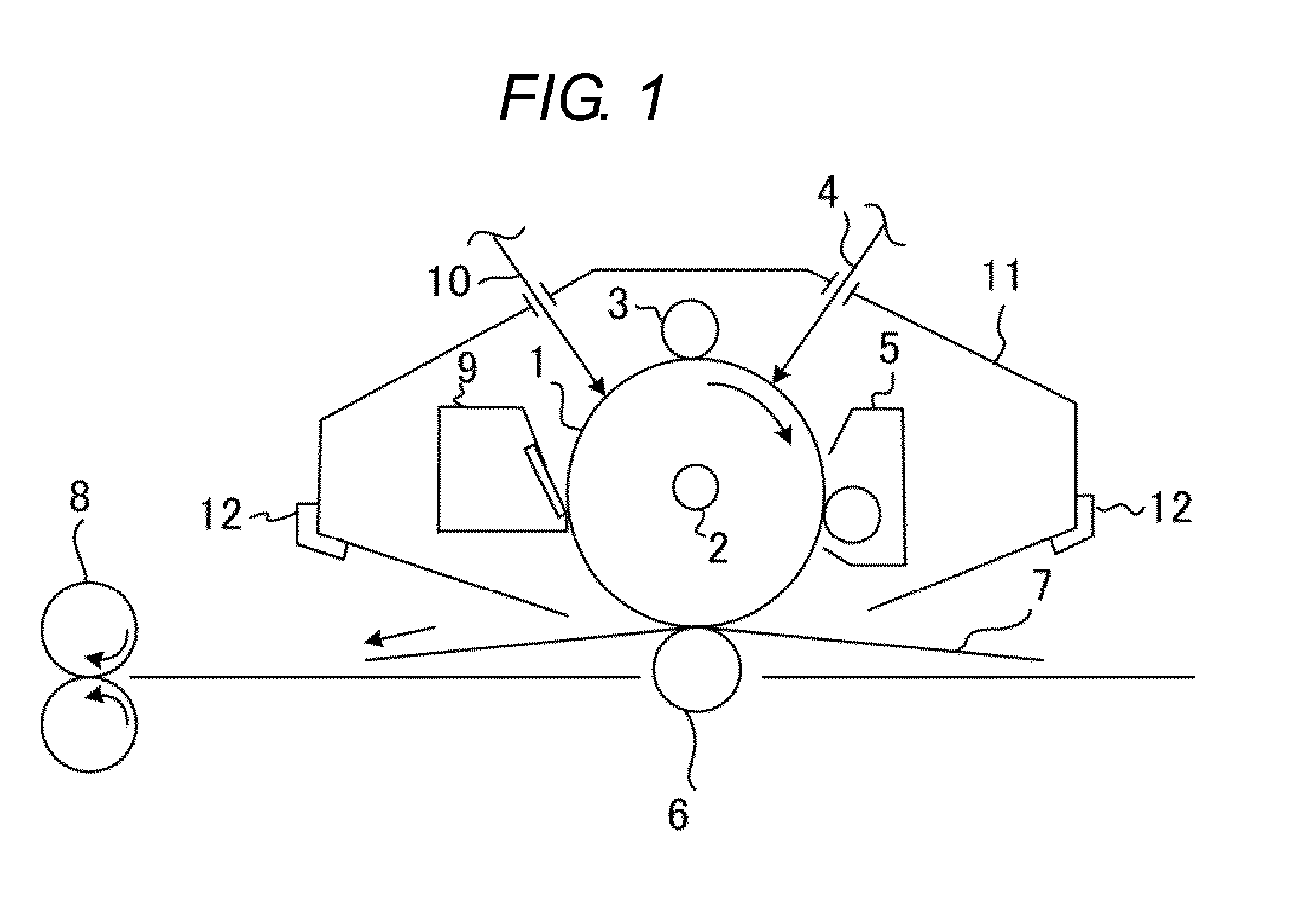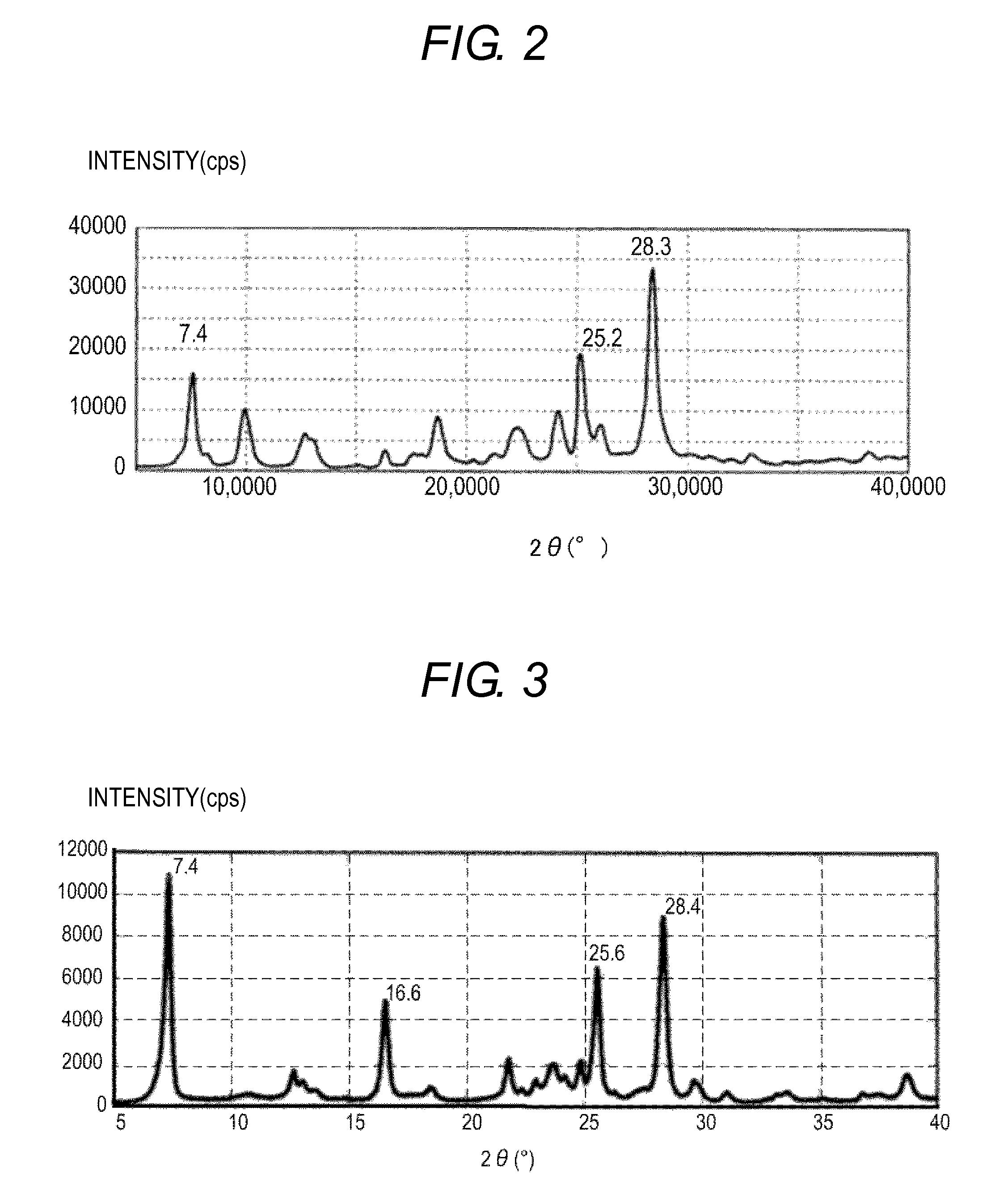Electrophotographic photosensitive member, process cartridge, and electrophotographic apparatus
a photosensitive member and electrophotography technology, applied in the direction of electrographic process apparatus, optics, instruments, etc., to achieve the effect of less image defects, less deterioration of image quality, and improvement of image quality
- Summary
- Abstract
- Description
- Claims
- Application Information
AI Technical Summary
Benefits of technology
Problems solved by technology
Method used
Image
Examples
synthesis example 1
[0111]In a nitrogen flow atmosphere, 5.46 parts of phthalonitrile and 45 parts of α-chloronaphthalene were added to a reaction furnace and heated up to a temperature of 30° C., and the temperature was maintained. Next, 3.75 parts of gallium trichloride was added thereto at the temperature (30° C.). The moisture value of the mixture at the time of addition was 150 ppm. After that, the mixture was heated to a temperature of 200° C. Next, in a nitrogen flow atmosphere, the mixture was allowed to react at a temperature of 200° C. for 4.5 hours and cooled, and the resultant product was filtered when the temperature reached 150° C. The filter residue was dispersed in and washed with N,N-dimethylformamide at a temperature of 140° C. for 2 hours, followed by filtration. The resultant filter residue was washed with methanol and dried to yield 4.65 parts (yield 71%) of a chlorogallium phthalocyanine pigment.
synthesis example 2
[0112]4.65 Parts of the chlorogallium phthalocyanine pigment obtained in Synthesis Example 1 was dissolved in 139.5 parts of concentrated sulfuric acid at a temperature of 10° C., and the solution was added dropwise with stirring to 620 parts of ice water to reprecipitate the pigment, followed by filtration using a filter press. The resultant wet cake (filter residue) was dispersed in and washed with 2% ammonia water, followed by filtration using a filter press. Next, the resultant wet cake (filter residue) was dispersed in and washed with ion exchange water, and then filtration using the filter press was repeated three times to yield a hydroxygallium phthalocyanine pigment having a solid content of 23% (aqueous hydroxygallium phthalocyanine pigment) (acid pasting treatment).
[0113]Next, 6.6 kg of the resultant hydroxygallium phthalocyanine pigment (aqueous hydroxygallium phthalocyanine pigment) was dried as described below using a hyper-dry dryer ((trade name: HD-06R, frequency (osc...
preparation example 1
[0120]0.5 Part of the hydroxygallium phthalocyanine pigment obtained in Synthesis Example 2 and 10 parts of N,N-dimethylformamide were subjected to wet milling treatment with a ball mill together with 20 parts of glass beads each having a diameter of 0.8 mm at room temperature (23° C.) for 400 hours. This step was carried out using a standard bottle (product code: PS-6, manufactured by Hakuyo Glass Co., Ltd.) as a container under a condition in which the container was rotated 120 times per minute. An organic compound-containing gallium phthalocyanine crystal was taken out from the dispersion thus obtained with N,N-dimethylformamide and filtered, and then the residue on the filter was sufficiently washed with tetrahydrofuran. The filter residue was vacuum-dried to yield 0.45 part of an organic compound-containing hydroxygallium phthalocyanine crystal. The powder X-ray diffraction spectrum of the resultant crystal is shown in FIG. 2.
[0121]In addition, NMR measurement confirmed that th...
PUM
 Login to View More
Login to View More Abstract
Description
Claims
Application Information
 Login to View More
Login to View More - R&D
- Intellectual Property
- Life Sciences
- Materials
- Tech Scout
- Unparalleled Data Quality
- Higher Quality Content
- 60% Fewer Hallucinations
Browse by: Latest US Patents, China's latest patents, Technical Efficacy Thesaurus, Application Domain, Technology Topic, Popular Technical Reports.
© 2025 PatSnap. All rights reserved.Legal|Privacy policy|Modern Slavery Act Transparency Statement|Sitemap|About US| Contact US: help@patsnap.com



